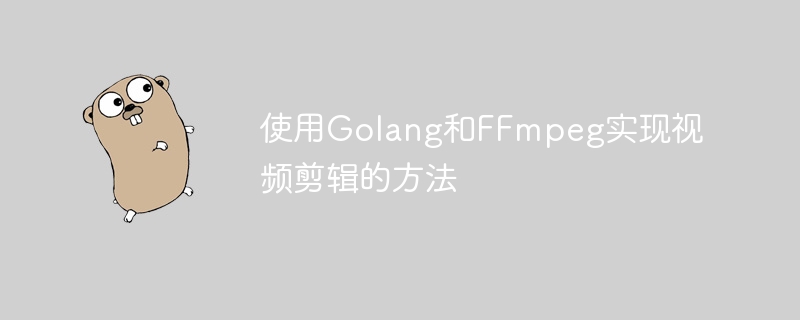

The method of using Golang and FFmpeg to implement video editing requires specific code examples
Overview:
Video editing is a common multimedia processing requirement, through editing Video can realize functions such as cropping, splicing, cutting and adding watermarks to videos. This article will introduce how to use Golang and FFmpeg libraries to implement video editing, and provide specific code examples.
Step 1: Install FFmpeg
First, we need to install FFmpeg. FFmpeg is an open source multimedia processing library that can be used on various platforms. For specific installation methods, please refer to the FFmpeg official website (https://ffmpeg.org/).
After the installation is complete, we need to add the FFmpeg executable file to the system environment variables so that we can call FFmpeg directly in the terminal or command line.
Step 2: Download Golang’s FFmpeg library
Golang’s FFmpeg library is a Go language library used to call FFmpeg functions. We need to introduce this library into the project. The library can be downloaded through the following commands:
go get github.com/giorgisio/goav/avcodec
go get github.com/giorgisio/goav/avformat
go get github.com/giorgisio/goav/ avutil
go get github.com/giorgisio/goav/swscale
Step 3: Code implementation of video clipping
The following is a sample code to implement video clipping using Golang and FFmpeg libraries:
1 2 3 4 5 6 7 8 9 10 11 12 13 14 15 16 17 18 19 20 21 22 23 24 25 26 27 28 29 30 31 32 33 34 35 36 37 38 39 40 41 42 43 44 45 46 47 48 49 50 51 52 53 54 55 56 57 58 59 60 61 62 63 64 65 66 67 68 69 70 71 72 73 74 75 76 77 78 79 80 81 82 83 84 85 86 87 88 89 90 91 92 93 94 95 96 97 98 99 100 101 102 103 104 105 106 107 108 109 110 111 112 113 114 115 116 117 118 119 120 121 122 123 124 125 126 127 128 129 130 131 132 133 134 135 136 137 138 |
|
The above code implements the basic functions of video editing. It first reads the frames of the video stream from the input file, and then writes the frames that need to be retained to the output file by judging the frame time. The functions provided by the FFmpeg library are used for reading, decoding, encoding and writing operations.
It should be noted that this example only edits a single video stream; if multiple video streams are involved, corresponding modifications need to be made based on the actual situation.
Conclusion:
This article introduces the method of using Golang and FFmpeg to implement video editing, and provides specific code examples. Readers can adjust and expand the code accordingly according to their own needs to achieve more complex and personalized video editing functions. At the same time, you can also learn more about video editing by reading the official FFmpeg documentation and Golang's FFmpeg library documentation.
The above is the detailed content of How to implement video editing using Golang and FFmpeg. For more information, please follow other related articles on the PHP Chinese website!




